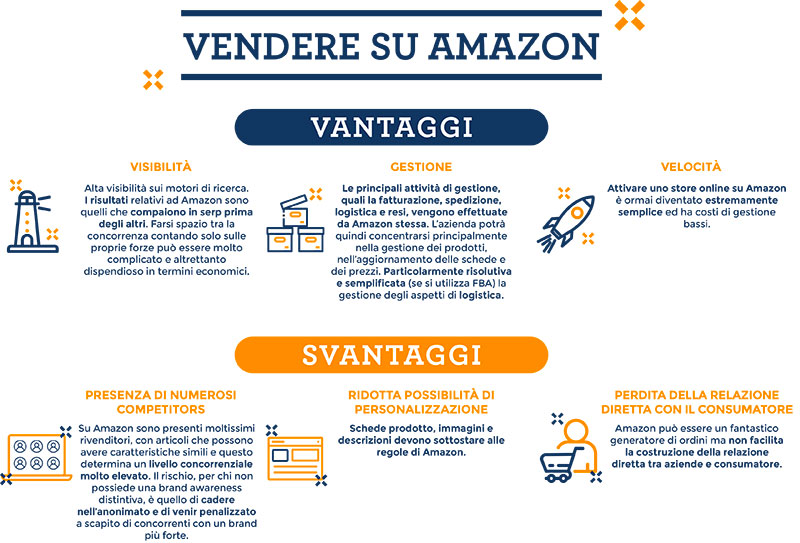In today’s digital marketplace, businesses face a crucial decision when entering the e-commerce space: should they leverage established marketplaces like Amazon or invest in building their own proprietary e-commerce platform? This comprehensive analysis examines both approaches, providing insights into their respective advantages, disadvantages, and strategic implications to help businesses make informed decisions.
The choice between Amazon marketplace and proprietary e-commerce is not merely a technical decision but a strategic one that impacts brand control, customer relationships, profitability, and long-term business sustainability. Each approach offers unique benefits and challenges that must be carefully evaluated against specific business objectives and market conditions.
Each of the possible paths brings with it advantages and disadvantages. Today to try to shed some light on them, we will analyze them together with Inthezon the company of Libera Brand Building Group, specializing in Amazon consulting since 2017 established with the goal of helping brands improve sales performance on Amazon by creating innovative digital shopping experiences.
Amazon Marketplace: Advantages and Opportunities
- Enhanced Visibility and Traffic
The first major benefit of having a presence on the Amazon marketplace is high visibility on search engines. Products listed on Amazon typically appear prominently in search results, often ranking higher than standalone e-commerce websites. This organic visibility provides immediate access to millions of potential customers without the need for extensive digital marketing campaigns.
- Simplified Operations Management
Amazon handles critical operational aspects including payment processing, order fulfillment, shipping logistics, and customer service through its comprehensive infrastructure. This operational support is particularly valuable for businesses utilizing the Fulfillment by Amazon (FBA) program, which provides Prime shipping benefits and enhanced customer trust.
The company will then be able to focus mainly on managing products, updating tabs and prices. This can be a great help if one is approaching online business for the first time because it allows one to start selling without having to organize from a logistical point of view with large outlays of time and money.
- Speed
Setting up an online store on Amazon is now extremely simple and has low overhead costs. And there is no doubt that this allows to start selling quickly compared to having to create and promote a proprietary platform from scratch, organize logistics, administrative and legal issues that arise if the goal, for example, is internationalization.
Disadvantages and Limitations
- Intense Competition and Price Pressure
The Amazon marketplace hosts millions of sellers, creating an extremely competitive environment where price often becomes the primary differentiator. This intense competition can erode profit margins and make it difficult for brands to establish premium positioning.
With a good positioning strategy, the right choice of catalog and good adv planning in the platform, however, it is certainly possible to get space and good results of in terms of sales.
- Limited Brand Control and Customization
Amazon’s standardized format severely restricts brand expression and customization opportunities. Product pages must conform to Amazon’s guidelines, limiting the ability to create unique brand experiences or implement specialized marketing strategies.
The platform’s focus on product-centric rather than brand-centric presentation can commoditize premium products and undermine brand differentiation efforts.
- Compromised Customer Relationship
Amazon, if managed properly, can be a fantastic order generator but does not facilitate the building of the direct relationship between business and consumer. If the goal, then, is to generate sales, Amazon may be the optimal solution. If, on the other hand, the strategy is to support the building or strengthening of brand awareness, for example, then other channels will probably be best.
Proprietary E-commerce: Advantages and Strategic Benefits
- Complete Brand Control and Customization
Proprietary e-commerce platforms offer unlimited customization possibilities, allowing businesses to create unique brand experiences that align with their positioning and values. Every aspect of the customer journey can be tailored to reinforce brand identity and create differentiated experiences.
This control extends to pricing strategies, promotional campaigns, and product presentation, enabling businesses to maintain premium positioning and avoid price-based competition.
- Visibility
It is true that initially a company with a proprietary e-commerce does not enjoy the same visibility that it could get thanks to the marketplace and that the costs of obtaining it are far greater. But at the same time, once users are on the platform, they cannot be distracted by competitors.
Direct customer relationships facilitate superior customer service, personalized communications, and the ability to gather detailed feedback for product development and improvement.
- Absence of Commission
As we know Amazon, as well as all marketplaces, charges commissions on sales that must be taken into account when building the business plan. With a proprietary e-commerce we will have many more initial expenses but no commission on sales.
The advantages of a proprietary e-commerce are certainly attractive but there are also some disadvantages to take into account including:
- Substantial Initial Investment and Ongoing Costs
Developing a proprietary e-commerce platform requires significant upfront investment in technology, design, and development. Ongoing costs include hosting, security, maintenance, updates, and technical support, which can be substantial for smaller businesses.
The total cost of ownership extends beyond initial development to include ongoing optimization, feature enhancements, and security updates required to maintain competitive functionality.
- Resource Requirements and Technical Expertise
Not being able to rely on Amazon’s logistics and customer care services, it will be necessary to provide for an investment in services and human resources that can cover the various pre- and post-sales tasks.
- Drive to E-commerce Activities
Perhaps the greatest challenge facing proprietary e-commerce is driving traffic and acquiring customers. Unlike Amazon’s built-in customer base, proprietary platforms must invest heavily in digital marketing, SEO, content marketing, and advertising to generate awareness and traffic.
Customer acquisition costs can be substantial, particularly in competitive markets, and require ongoing investment to maintain growth momentum.

In conclusion, we cannot say that there is a one-size-fits-all solution. The choice between Amazon and proprietary e-commerce depends on your business goals and strategies.
What we feel like advising, even if you choose to build a custom platform is to consider a first approach on Amazon, which is, in general, a great tool to start testing the market grip of products.
Based on the results obtained from Amazon you will have clearer data on how to set up an online sale through a proprietary channel.
It is also possible to make one’s e-commerce and Amazon profile coexist without fear that they will cannibalize. Several avenues are possible to achieve this and, again, it depends on the specific business needs. One can, for example, create a product line specifically for Amazon users so that it does not compete with proprietary sales channels, whether online or physical. Or one can build a site that links back to Amazon for the e-commerce part. That is, Amazon handles the payment processing and logistics. This way customers can find us both on the marketplace and on our proprietary site by concluding the purchase on Amazon. This can be a good option to make two sales channels coexist at the same time without having to bear all the logistical and organizational expenses required by an independent e-commerce.
Whatever the choice, the advice is always to evaluate well which products to focus on, calculate the margin net of commissions or at out-of-pocket costs, and tailor the offer to that of the competition.
Roberto Botto.
Ceo di Inthezon, società di Libera Brand Building Group
Note: The content of this analysis represents independent evaluations by Inthezon and not those of Amazon or brand associated with in.
